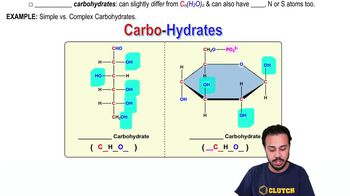Carbohydrates quiz #1 Flashcards
Terms in this set (23)
What are the three size classes of carbohydrates?
The three size classes of carbohydrates are monosaccharides, oligosaccharides, and polysaccharides.
What does the prefix 'mono' in monosaccharide mean?
The prefix 'mono' means one or singular.
What is an example of a monosaccharide?
Glucose is an example of a monosaccharide.
How many monosaccharide units are in oligosaccharides?
Oligosaccharides are composed of 3 to 10 monosaccharide units.
What is a disaccharide?
A disaccharide is an oligosaccharide with two monosaccharide units linked together.
What does the prefix 'poly' in polysaccharide mean?
The prefix 'poly' means many.
What type of bond links monosaccharides together in polysaccharides?
Glycosidic bonds link monosaccharides together in polysaccharides.
What reaction is needed to break down polysaccharides into monosaccharides?
Hydrolysis reactions are needed to break down polysaccharides into monosaccharides.
What is the main function of cellulose in plants?
Cellulose provides structural support in plant cell walls.
What polysaccharide is used for energy storage in animals?
Glycogen is used for energy storage in animals.
What is the function of chitin in animals?
Chitin provides structural support in the exoskeletons of insects and crustaceans.
What is the primary function of starch in plants?
Starch is used for energy storage in plants.
What process is used to synthesize polysaccharides from monosaccharides?
Dehydration synthesis reactions are used to synthesize polysaccharides from monosaccharides.
What is the most abundant carbohydrate in plant cell walls?
Cellulose is the most abundant carbohydrate in plant cell walls.
What is the role of glycosidic bonds in carbohydrates?
Glycosidic bonds are covalent bonds that link monosaccharides together in carbohydrates.



